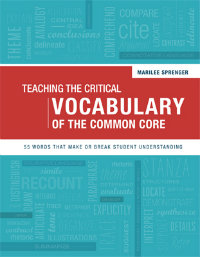Teaching the Critical Vocabulary of the Common Core: 55 Words
Teaching the Critical Vocabulary of the Common Core:
55 Words That Make or Break Student Understanding
By Marilee Sprenger
(ASCD, 2013 – Learn more)

Three cheers for Marilee Sprenger’s Teaching the Critical Vocabulary of the Common Core: 55 Words That Make or Break Student Understanding. This book is a must-have for classroom teachers, librarians, principals and instructional coaches and supervisors. While some of the activities may seem elementary, even middle and high school students will benefit from knowing these critical words.
What are the 55 critical words?
Early on, Marilee Sprenger tells us that the words in this book “are not uncommon, but for one reason or another, they have not entered most of our students’ long-term memories nor have they been rehearsed to a point where they are automatically recognized, defined, and acted upon.” Hence her use of the word “critical” in the book’s title.

The author’s goal for Teaching the Critical Vocabulary of the Common Core is to show teachers “how to get these critical words, and other words as well, into long-term memory.” She has grouped the critical words into two categories: verbs and nouns. These words come from the anchor standards, grade-level standards, and exemplars of the Common Core State Standards.
For convenience, each group of words is arranged in alphabetical order; she also includes a list showing the grade level in which the words are introduced. This list is extremely important to teachers since students have to store all these words in their memories.
Teaching the words
The author advocates pre-assessing the words in order to plan instruction. Each critical word is supported with multiple strategies and activities that address various learning styles. Among the techniques Sprenger suggests are jingles, movement, art, mnemonics, vocabulary word gloves and paper foldables – a variety of approaches to get these words into students’ long-term memories. She supports content-area teachers with ideas and activities for teaching and using these words. Old standbys like Password, Mystery Word, and Charades are suggested to reinforce learning.
Activities like Word Maps, 3-D Graphic Organizers, T-Charts, and Venn Diagrams can be used by the entire school. Throughout the book she provides helpful reminders:
- have the students write the word in color to help them remember it
- use the word and its various forms throughout class
- teach vocabulary in fun ways to help students learn the words
The word determine appears in the Common Core beginning in grade one. For this word, there are multiple activities: Concept Map, Vocabulary Word Map, Graphic Organizer and a Word Search. With the Word Search activity, as students circle the word determine, they say the definition or jingle aloud. A fun way for younger students to move the word to long-term memory! Remember, students must have quick, easy access to this word in middle and high school.
When teaching the word interpret, Sprenger suggests having students first study Norman Rockwell’s art to discuss what they see before interpreting what they read. This lesson, combined with the ideas for teaching illustrations, will help students see the connections between the art and the words in any text.
For the word conclusions, she suggests reading the first few sentences of a passage aloud and asking students to draw conclusions about what they think the story will be about. At the end of the reading, continue the lesson by discussing the evidence that supports, or doesn’t support, their original conclusions. She includes a graphic organizer conclusion chart, along with two websites to support the retention of this word.
Sticky learning
These low-cost, easy-prep activities are especially “critical” for high-poverty schools and schools with a large population of English Language Learners. In Chapter 7, “Making Them Stick,” the author offers classroom strategies, school wide strategies, and community strategies for growing students’ vocabularies.
And, if you want to know what the remaining fifty critical words are, refer to Teaching the Critical Vocabulary of the Common: Core 55 Words That Make or Break Student Understanding by Marilee Sprenger.
Anne Anderson finally got out of the 8th grade after 24 years and 9 weeks. She spent the next 9 years sharing her expertise in literacy and writing with K-12 teachers and administrators throughout the district. She credits National Writing Project and Poetry Alive! as turning points in her growth as a teacher. She now shares her expertise nationwide as an Educational Consultant and through her website and her bi-monthly newsletter, Spotlight on Success.




























